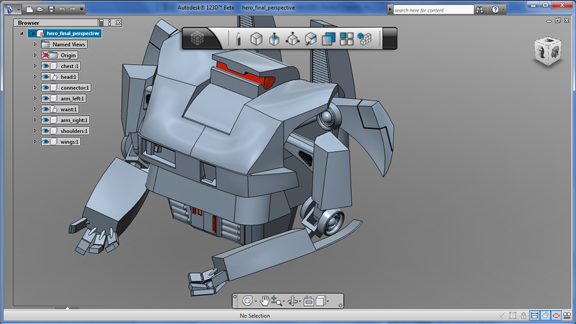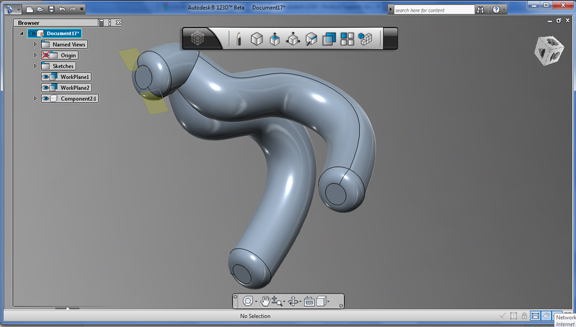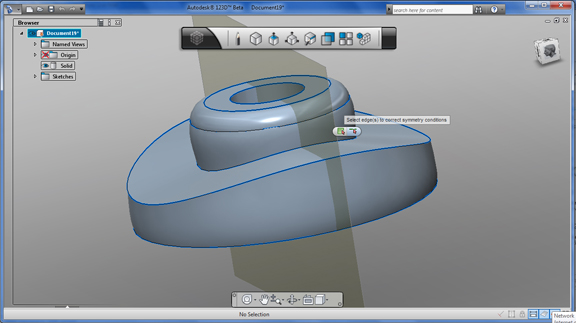June 2, 2011



The dam broke when Google unleashed SketchUp, a free software that makes modeling as easy as pushing and pulling on faces. The software’s easy, intuitive approach did something most parametric CAD programs couldn’t do—allow someone to start modeling a part in less than an hour. By its success, SketchUp forces CAD software giants—and many CAD users—to rethink the conventional wisdom that 3D modeling has to be difficult.
Following SketchUp’s emergence, Dassault Systemes released 3DVIA Shape, an easy-to-use, push-pull 3D modeler that lets you create fairly detailed objects without a lot of efforts. Aimed at attracting people with little or no experience in mechanical modeling or industrial design, the software is a dramatic departure from Dassault’s professional products, like SolidWorks and CATIA.
In May, Autodesk launched its own easy 3D modeler, dubbed Autodesk 123D. The software, currently a free Beta download, is described as “a free solid modeling software program based on the same Autodesk technology used by millions of designers and engineers worldwide. Not an engineer? No problem, with Autodesk 123D you can design precise and makeable objects using smart tools that let you start with simple shapes and then edit and then tweak them into more complex shapes.”
The software looks and feels like a limited version of Autodesk Inventor Fusion. Current export/import options are limited to the software’s native .123d, DWG, STEP, and STL—not an extensive list that would allow you to freely exchange and edit files with suppliers using other CAD programs, but enough to create something ready for a rapid prototyping machine or a service bureau.
It offers the same push-pull geometry editing and face rotation that Autodesk introduced in Inventor Fusion. The software comes with a Freeform command, which lets you pick a spline or an edge and reshape its profile by manipulating the control points. The same command gives you Symmetry, which lets your geometry edits from one side to reflect on the other side.
But there are a few peculiar interface behaviors I noticed. In creating solids using the Sweep command, for example, you’d have to select the profile, select the sweep path (so far, so good), then select the Boolean glyph and set it to New Component (that threw me off a bit). Until you execute the two later steps, you won’t be able to see a preview of your sweep profile. After selecting the profile and the sweep path, the software doesn’t give you a text prompt about the Boolean glyph (what is that anyway?), so you might be at a loss as to how to proceed. (I was, until I begrudgingly decided to consult the online Help.)
Such quirks, of course, are not uncommon in a Beta release, so we can expect Autodesk to refine 123D’s interface in later versions. The new software is a spawn of Inventor Fusion, technically a history-free CAD program, so it may not be that easy for those unfamiliar with CAD protocols to figure out on their own (that is, compared to a package like SketchUp). That’s where the vast collection of multimedia tutorials Autodesk has created will come in handy.
Autodesk 123D’s launch is accompanied by the debut of a new content-sharing portal, similar to Dassault’s 3DVIA.com and 3DContentCentral.com. The searchable content database includes certain standard mechanical parts (such as fasteners, shafts, pipes, tubes) and popular objects (such as vehicles, electronic devices, and spacecrafts). Currently, the models are only available in the .123d format, native to Autodesk 123D software. The embedded viewer at the site lets you preview mesh models and shaded models from your browser before you download it.
The 123D initiative also involves 3D Systems, a rapid-prototyping machine maker; TechShop, a member-accessible workshop locations; and Ponoko, a service bureau that will help you create your digital model into a physical one for a fee. These partnerships advance 123D from a simple digital modeler to a physical part making tool. It also brings Autodesk closer to a new market—amateurs, hobbyists, 3D enthusiasts, craft-fair participants, garage-bound tinkerers, and homegrown inventors. Sometimes called DIYers (Do-It-Yourself-ers), they are characterized by a desire to experiment, tinker, build, and produce personal objects.
It’s a market also courted by SolidWorks, a Dassault subsidiary, and Alibre Design, a Texas-headquartered CAD developer with a low-cost option ($199) for personal use. Autodesk and SolidWorks both lobbied to place their software into the hands of TechShop members, through CAD classes offered at the workshop locations. Currently, Autodesk software classes heavily outnumber classes devoted to other CAD software brands at TechShop. Alibre continues to recruit users for its Alibre Design Personal Edition at the annual Makers Faire, a haven for craft-makers, artists, and the do-it-yourself crowd.
Though Autodesk and its major competitors currently cater to the professional market, they’re evidently keeping an eye on the horizon beyond, where many younger consumers, nurtured by Google SketchUp, may be ready for their first taste in an introductory CAD program.
For more, watch the video report below:
Subscribe to our FREE magazine, FREE email newsletters or both!
About the Author
Kenneth Wong is Digital Engineering’s resident blogger and senior editor. Email him at [email protected] or share your thoughts on this article at digitaleng.news/facebook.
Follow DE





